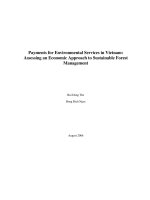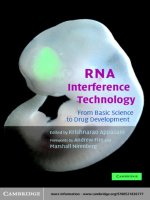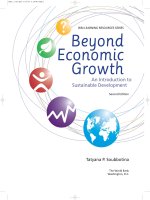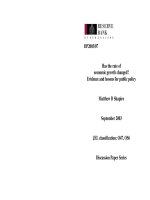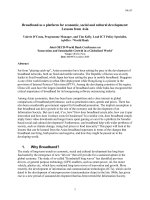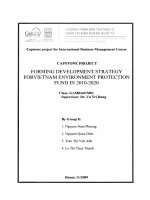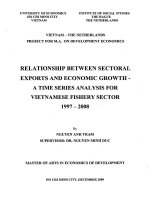From economic growth to sustainable development lessons for vietnam
Bạn đang xem bản rút gọn của tài liệu. Xem và tải ngay bản đầy đủ của tài liệu tại đây (80 KB, 85 trang )
UNIVERSITY OF ECONOMICS
HO CHI MINH CITY
VIETNAM
INSTITUTE OF SOCIAL STUDIES
THE HAGUE
THE NETHERLANDS
VIETNAM – THE NETHERLANDS
PROGRAMME FOR M.A IN DEVELOPMENT ECONOMICS
FROM ECONOMIC GROWTH TO
SUSTAINABLE DEVELOPMENT:
LESSONS FOR VIETNAM
BY
NGUYEN THI HONG
MASTER OF ARTS IN DEVELOPMENT ECONOMICS
HO CHI MINH CITY, NOVEMBER 2012
UNIVERSITY OF ECONOMICS
HO CHI MINH CITY
VIETNAM
INSTITUTE OF SOCIAL STUDIES
THE HAGUE
THE NETHERLANDS
VIETNAM - NETHERLANDS
PROGRAMME FOR M.A IN DEVELOPMENT ECONOMICS
FROM ECONOMIC GROWTH TO
SUSTAINABLE DEVELOPMENT:
LESSONS FOR VIETNAM
A thesis submitted in partial fulfilment of the requirements for the degree of
MASTER OF ARTS IN DEVELOPMENT ECONOMICS
By
NGUYEN THI HONG
Academic Supervisor:
ASSOCIATE PROFESSOR DR. PHAM HOANG VAN
ASSOCIATE PROFESSOR DR. NGUYEN TRONG HOAI
HO CHI MINH CITY, NOVEMBER 2012
DECLARATION
I would like to declare that this thesis:" From economic growth to sustainable
development: Lessons for Vietnam" is original. I ensure that this paper has not been
submitted anywhere for the award of any degree.
This thesis was completed with big support from my supervisors. All source of data
and information have been fully referenced.
NGUYEN THI HONG
MDE16
i
ACKNOWLEGDEMENT
I would like to express my greatest gratitude to respectful supervisors, Associate
Professors – Dr. PHAM HOANG VAN, Baylor University and Dr. NGUYEN TRONG
HOAI, Vice President of UEH. They already helped and supported me many interesting
courses, especially valuable advice, guidance and inspiration for me finish this study on time.
I also want to express my thanks to all Professor of the MDE Program during the past
two years (2009-2011), my friends of MDE16, UEH administrative staff at Economic
Development Faculty, who supported many useful documents and materials. I cannot forget
the support from my big family all the time I followed this program.
At last but not the least, I am so sorry and would like to share my condolences when
Professor KAREL JANSEN - who had great contributions to the program - passed away.
That was really a big loss for all of us.
Best regards.
NGUYEN THI HONG
MDE 16
ii
ABSTRACT
In the scenes of strong economic development all over the world during some decades
ago, the new problems that are happening everywhere is the consequence of progress can be
attract more concerns of economists. That is the trade-off of economic achievements and the
degradation of environment, the exploitation of natural resources, the global warming, the rise
of sea level and so on. The new concept about development - sustainable development - now
becomes familiar. It is a new economic approach to express the development which care not
only economic growth but also reservation of the natural resources, the environmental
pollution, the investment on education.
From that point of view, by using data of 90 countries, the author hopes to find out the
relationship between sustainable development and other determinants such as GDP growth,
export of natural resources and agricultural products, urban population growth, Human
Development Index, corruption impact and so on. I strongly believe that the discovery of
these relationships can provide some valuable lessons for development progress for
developing countries and Vietnam.
Key words: sustainable development, economic growth, adjusted net savings
iii
TABLE OF CONTENT
DECLARATION ............................................................................................................................. i
ACKNOWLEGDEMENT .............................................................................................................. ii
ABSTRACT ................................................................................................................................... iii
TABLE OF CONTENT ................................................................................................................. iv
LIST OF ABBREVIATIONS ........................................................................................................ vi
LIST OF TABLES ........................................................................................................................ vii
LIST OF FIGURES, GRAPHS ................................................................................................... viii
CHAPTER I .................................................................................................................................. 1
INTRODUCTION......................................................................................................................... 1
1.1Research background ................................................................................................................. 1
1.2 Statement of problem ............................................................................................................... 2
1.3 Research objectives ................................................................................................................... 3
1.4 Research questions .................................................................................................................... 4
1.5Research methodology ............................................................................................................... 4
1.6 Structure of thesis ..................................................................................................................... 5
CHAPTER II ................................................................................................................................. 6
LITERATURE REVIEW FOR SUSTAINABLE DEVELOPMENT ..................................... 6
2.1 Concepts of economic growth, economic development and sustainable development ............ 6
2.2 Approaches of sustainable development ................................................................................... 8
2.3 Objectives and significance of sustainable development ........................................................ 10
2.4 Indicators of sustainable development ................................................................................... 11
2.5 Linkage of various determinants of sustainable development ................................................ 14
2.6 Benefits and drawbacks of adjusted net savings ..................................................................... 15
2.7 Empirical Models .................................................................................................................... 16
2.8 Empirical studies relating to sustainable development ........................................................... 22
2.10 Chapter remarks .................................................................................................................... 30
CHAPTER III ............................................................................................................................. 32
RESEARCH METHODOLOGY AND DATA COLLECTION ............................................ 32
3.1 Econometric techniques .......................................................................................................... 32
iv
3.2 Data collection ........................................................................................................................ 35
3.3 Data analysis ........................................................................................................................... 35
3.4 Chapter remarks ...................................................................................................................... 36
CHAPTER IV.............................................................................................................................. 37
RESEARCH RESULTS ............................................................................................................. 37
4.1 Descriptive statistics ............................................................................................................... 37
4.2 Relationship between adjusted net saving and other factors .................................................. 41
4.3 Empirical analysis ................................................................................................................... 44
4.4 Chapter remarks ...................................................................................................................... 53
CHAPTER V ............................................................................................................................... 55
SUSTAINABLE DEVELOPMENT IN VIETNAM ................................................................ 55
CHAPTER VI.............................................................................................................................. 58
CONCLUSIONS AND RECOMMENDATIONS .................................................................... 58
6.1 Main findings .......................................................................................................................... 58
6.3 Limitations of thesis title ........................................................................................................ 61
6.4 Further research ...................................................................................................................... 61
REFERENCES ............................................................................................................................ 62
APPENDIX
v
LIST OF ABBREVIATIONS
ADB
Asian Development Bank
IMF
International Monetary Bank
NGO
Non Governmental Organization
CO2
Carbon Dioxide
CPI
Corruption Perception Index
ELF
Ethno-Linguistic Fractionalization
GDP
Gross Domestic Product
GDPPC
Gross Domestic Product per capita
GNI
Gross National Income
HCMC
Ho Chi Minh City
HDI
Human Development Index
MPI
Ministry of Planning and Investment
OECD
The Organization for Economic Cooperation and Development
OLS
Ordinary Least Squares
TFP
Total Factor Productivity
TSLS
Two Stage Least Squares
UN
The United Nations
UNCED
The United Nations Conference on Environment and Development
UNDP
The United Nations Development Program
WB
The World Bank
WTO
World Trade Organization
WCED
World Commission on Environment and Development
vi
LIST OF TABLES
Table 2.1: Expectation the influence of determinants on adjusted net savings ................ 22
Table 2.2: Summary of empirical studies relating to sustainable development. .............. 27
Table 4.1: Descriptive statistics ........................................................................................ 39
Table 4.2: Covariance and correlation .............................................................................. 40
Table 4.3: Regression adjusted net savings and GDP growth rates by OLS .................... 44
Table 4.4: Regression adjusted net savings and GDP growth rates by TSLS .................. 46
Table 4.5: Regression adjusted net savings and GDP per capita by OLS ........................ 47
Table 4.6: Regression adjusted net savings and GDP per capita by TSLS....................... 48
Table 4.7: Regression adjusted net savings on Export of agricultural raw products ........ 50
Table 4.8: Regression adjusted net savings on Export of natural resources .................... 51
Table 4.9: Regression adjusted net savings with GDP growth rates in developing countries
........................................................................................................................................... 52
Table 4.10: Summary results ............................................................................................ 54
Table 5.1: Vietnam Data ................................................................................................... 55
vii
LIST OF FIGURES, GRAPHS
Figure 2.1: Linkage of various determiants of sudtainable development……………….15
Graph 2.1: How to calculate adjusted net savings ............................................................ 12
Graph 2.1: Conceptual framework .................................................................................... 30
Graph 4.1: Relationship between Adjusted net savings and GDP growths (1996-2010) . 41
Graph 4.2: Relationship between Adjusted net savings and and GDPPC2010 ................ 42
Graph 4.3: Relationship between Adjusted net savings and export of agricultural raw products
in period 1996-2010 .......................................................................................................... 42
Graph 4.4: Relationship between Adjusted net saving and and export of natural resources in
period 1996-2010 .............................................................................................................. 43
Graph 4.5: Relationship between Adjusted net savings and GDP growth of developing
countries in period 1996-2010 .......................................................................................... 44
viii
CHAPTER I
INTRODUCTION
1.1 Research background
Economic growth affects national wealth or income per capita by increasing its Gross
Domestic Production or Gross National Income. Research about economic growth and its
influences on environment and society always attract interest from economists all over the
world. Moreover, some targets of economic growth are directly to the sustainable use of these
natural resources and environmental protection. It means that economic growth is not at all;
many countries are saving of their scare natural resources than in some past decades for future
generations instead of the exploiting them and not paying any attention to these environmental
degradation.
Since the first appearance in the Brundtland report at World Commission on
Environment and Development in 1987, the concept of sustainable development has become
popular in many countries.1 The relationship between economic growth and sustainable
development has consideration from economists. Expressing sustainable development by
genuine saving rates or adjusted net savings, many studies found that sustainable development
has a consistent relationship with economic growth.
Hamilton et al. (1999) measured genuine saving rates of countries both developing
and developed countries. These rates were calculated by combination of different factors as
gross savings, fixed capitals, educational expenditures and polluted emissions. They found
that genuine saving rates were positive values in high-income countries and negative values
in developing countries. Negative rates of genuine savings would lead to declining of wellbeing.2
1
The United Nations, Report of the World Commission on Environment and Development: Our Common
Future, 1987
2
Hamilton C. (1999), “The genuine progress indicator: methodological developments and results from
Australia.” Ecological Economics 30: 13–28.
1
Atkinson et al. (2003) studied the relationship between natural resource abundance
and growth rate of GDP per capita. The result shows a negative and significant relationship
between natural resource abundance and growth rate of GDP per capita. 3
By measuring genuine saving of Taiwan and United Kingdom- one developed country
and one industrial country in Asia, Grace et al. (2004) found that low annual GDP growth rate
of United Kingdom corresponded low rate of genuine saving ratio to GDP. 4
A study of genuine savings by Dietz et al. (2007), genuine saving rates of rich and
poor natural resource countries and some factors affecting them. They found that rich resource
countries had lower genuine saving rates than poor resource countries. Moreover, this negative
effect will decrease when institutional quality improves.
Therefore, economic growth affects significantly to genuine saving rate of a nation.
Many other factors such as institutional quality, abundance of resources affected genuine
saving rates at different levels. Genuine saving rates depend largely on economic growth rate;
developed countries usually have higher genuine saving rates than developing countries.
1.2 Statement of problem
Economic growth rates of Vietnam in some decades ago were very impressive,
especially after VIETNAM implemented its “Doi Moi” policy in 1986. Since that time,
VIETNAM has followed these new economic strategies, enhancing the market openness with
international corporations. VIETNAM has become one of the economy that have high
economic growth rates in Asia. Economic growth has given chances to improve standards of
living. However, after nearly 30 years of the “Doi moi” stage, VIETNAM is still one of these
poorest countries in the world with income per capita was only 723$US in 2010 though the
average rate of economic growth in Vietnam was about 7.07% over the period of 1996-2010.
5
3
Atkinson G., Hamilton K. (2003), “Saving, Growth and the Resource Curse Hypothesis.” World Development
31: 1793–1807.
4
Grace T. R. Lin, Hope C. (2004), “Genuine savings measurement and its application to the United Kingdom
and Taiwan”, The Developing Economies XVII-1: 3−41.
5
/>
2
Comparing Vietnam with some other countries such as Singapore and the Netherlands
in the period from 1996 to 2010, we can see that an annual average growth rate of GDP in
Singapore was 5.87%, GDP per capita in 2010 was US$32,641. While the annual average
GDP growth of the Netherlands was only 2.2%, GDP per capita in 2010 is US$26,553.
Singapore and Netherlands are countries with high income while Vietnam is in a low-middleincome group. 6 The problem of nations with higher economic growth rates but lower income
per capita happens all over the world.
Is there a paradox in economic growth and
development?
In this context, a new concept - sustainable development or genuine saving – brings
a new look for evaluating the quality of growth or the wealth of a nation. By building on the
basis of gross saving and calculating many other factors which connect to fixed capital,
education, environment and natural resources, it is more useful and valuable than these
traditional indicators. Since 1996, the World Bank has used this indicator under the name
“adjusted net saving” in World Development Indicators. It also presents in the Little Green
Data Book from 2000.
Exploring the relationship between economic growth and other aspects of life such as
society, environment, natural resources, the impact of consumption of current generation with
the future generations still has been lacking until now, especially researches about the impact
of economic growth on sustainable development in Vietnam.
1.3 Research objectives
This paper will analyze the impact of economic growth and other factors on
sustainable development, especially sustainable development in Vietnam. It uses data of 90
nations from the World Bank source over the period from 1996 to 2010.
These main objectives will be as follows:
1.3.1 Evaluating the significance of economic growth on sustainable development.
6
/>
3
1.3.2 Evaluating the effect of export raw agricultural products on sustainable
development.
1.3.3 Evaluating the effect of export natural resources on sustainable development.
1.3.4 Evaluating the significance of economic growth on sustainable development in
developing countries
1.3.5 Finding valuable lessons for sustainable development in Vietnam.
1.4 Research questions
From these above objectives, this paper will find answers to these questions:
1.4.1 Will faster growth lead to sustainable development?
1.4.2 Will wealthier economies be more sustainable than poorer economies?
1.4.3 Does the increased export of raw agricultural products lead to decrease of
sustainable development?
1.4.4 Does the increased export of natural resource lead to decrease of sustainable
development?
1.4.5 Will faster growth lead to sustainable development in developing countries?
1.4.6 Which lessons should Vietnam could apply to maintain the state of sustainable
development?
1.5 Research methodology
This paper will apply both qualitative and quantitative methods for estimating the impact
of economic growth such as GDP growth on sustainable development by OLS estimation.
From models which are built up base on the empirical studies a long time ago, the paper will
be set up hypotheses and test the validity of proposed hypotheses by econometric techniques.
For solving the problems of endogeneity between sustainable development and GDP
growth, the paper will apply TSLS estimation. This estimation is used to test whether or not
there are reverse causation between GDP growth and sustainable development. It will be
4
applied for finding the answer about the question: Do high adjusted net savings lead to high
GDP growth? 7
1.6 Structure of thesis
This thesis consists of six chapters in which chapter I will introduce the general view
about the background of research, the necessary of thesis for Vietnam context of economic
growth and sustainable development. Chapter II will review literature about economic
growth, economic development and sustainable development. It will also discuss empirical
studies done by other researchers some decades ago. Chapter III will show the data collection,
analysis data and econometric techniques, which apply analysis data. Chapter IV will display
the results, which were found out by testing hypothesis relating to models in this thesis.
Chapter V will derive a state of sustainable development and some main points of Agenda
21 in Vietnam. The end chapter will summaries all main findings and suggests some available
policies. It also shows some limitations of this research topic and suggest some further
possibilities for future.
7
Dimitrios Asteriou and Stephen G. Hall, Applied Econometrics a modern approach, revised edition, Palgrave
Macmillan, 2007.
5
CHAPTER II
LITERATURE REVIEW FOR SUSTAINABLE DEVELOPMENT
This chapter supplies review literature that relates to the economic growth and
sustainable development. It also mentions their significance, methods of the measurement,
empirical studies over the world some past decades. From that, I will suggest appropriate
models for measuring the relationship between economic growth and sustainable
development.
2.1 Concepts of economic growth, economic development and sustainable development
2.1.1 Economic growth
Economic growth is quantitative change or expansion in a country's economy.
Economic growth is conventionally measured as the percentage increase in GDP or GNP
during one year (World Bank).
Traditionally, economists have made little distinction between economic growth and
economic development. Economic growth is necessary but it is not sufficient condition for
economic development. Moreover, GDP is still a narrow measure of economic welfare. It
does not consider to the importance of other aspects. Those are more leisure time, access to
health and education, environmental protection, freedom and social justice.
2.1.2 Economic development
While economic growth usually refers to increase in a country's production or income
per capita, economic development mentions to broadly scope. From the point of view of E.
Wayne - Kansas State University- economic development refers to economic growth
accompanied by changes in output distribution and economic structure. He stressed that the
improvement in material well-being of the poorer half of the population, a decline in
agriculture's share of GNI and corresponding in the increase in the GNP share of industry and
service, an increase in education and skill of labor force and substantial technical advances
originating within the country.8
8
E. Wayne Nafziger, Economic Development, fourth edition, Cambridge University Press, 2006
6
So economic development is qualitative change in a country's economy in connection
with technological and social progress. Main indicator of economic development is increasing
GNP per capita or GDP per capita, reflecting an increase in economic productivity and average
material well being of a country's population.
Three main objectives of economic development include:
(1) To increase the ability and widen the distribution of basic-life sustaining goods;
(2) To raise the level of livings;
(3)To expand the range of economics and social choices
So, there are many indexes to measure and evaluate the development of one nation. It
depends on development approaches, for example, HDI index for measuring the development
of humans and GINI index for measuring inequality in distribution of income and so on.
The United Nations Development Program (UNDP) ranks the development of a nation
by Human Development Index in yearly reports. This index calculates the human
development by combining three factors: income, life expectancy and education.
The GINI index measures the income distribution between the rich and total income
of a nation. It stresses the equality of income distribution. This problem happens within a
country and from country to country. It also occurs in top developed countries.
2.1.3 Sustainable development
There have been many different definitions about sustainable development. The
United Nations Brundtland report at World Commission on Environment and Development
in 1987 gives a basic idea about sustainable development. This concept defines sustainable
development as : “… meets the needs of the present without compromising the ability of
future generations to meet their own needs..."9.
This definition expressed strongly that the current consumption of resources for
economic development should not affect future generations. This definition gives a general
9
The United Nations, Report of the World Commission on Environment and Development: Our Common
Future, 1987, p.15
7
concept for development; it did not give a way to measure factors contributing on
sustainability.
Pezzey (1992) defined sustainable development as a non-declining utility. This
definition is one of basic concepts in sustainable development. Moreover, Pearce and
Atkinson (1997) developed a new paradigm of sustainable development, and they favor on
the strong sustainability. 10
The Organization for Economic Cooperation and Development – OECD defines that: “
sustainable development as development path along which the maximization of human wellbeing for today ‘s generations does not lead to declines in future well-being” 11
The United Nations (2008) stated that sustainable development should ensure the nondecline of wealth of a nation over time. The development of a nation is based on many kinds
of stocks for production such as fixed capital, human capital, social capital and natural capital
so it should compensate for a decline of these capital stocks. The UN group proposed some
small set of indicators for international comparison. They found that this concept was difficult
to define and measure with precision.12
2.2 Approaches of sustainable development
There are two possibilities for sustaining growth. First, there is insufficient
substitutability between reproducible capital and nonrenewable resources so that economic
growth can be sustained while the nonrenewable resource stocks decline continuously.
Second, technological changes will enable society to shift from reliance on non-renewable
resource to another and finally to a new renewable resource.
Two approaches regarding sustainability refer to the ecological and the neoclassical
paradigms. In other words, that is strong or weak sustainability. Weak and strong
sustainability are terms of whether reproducible and natural capital will keep intact together
or separately. The degree of substitutability between natural capital and reproduced capital is
the subject of considerable debate.
10
Pezzey J. (1992), “Sustainable Development concepts.” World Bank Environment paper Number 2
OECD, 2001, “Sustainable Development: Critical issues”, p. 2
12
The United Nations, 2008, “Measuring Sustainable Development”
11
8
Natural capital means the natural resources such as coal, oil, forest, land and
reproduced capital means human capital or human made capital. Because human made capital
can substitute for natural capital to some extent reproducible capital, it can reduce society's
reliance on natural resources by increasing the usefulness of services provided by non
renewable and renewable stocks.
Weak sustainability requires a high degree of substitutability between reproducible
and natural capital. According to this approach, more valuable human made capital will
replace the natural capital and the value of aggregate stock will increase overtime.
Strong sustainability stresses the substitutability between natural and reproduced
capital. It is difficult to ensure that future economic opportunities are maintained without
imposing some conditions on the depletion of natural capital.
2.2.1 Weak sustainability: the neoclassical paradigm
Weak sustainability refers to development which is not diminishing from one
generation to another. It comes from ideas of economists rather than ecologists. This means a
constraint on growth which Pezzey (1992) pointed out it as non-declining welfare over time.
In the case of reduction of welfare, he called it as “survivability”.
Based on the idea of unlimited substitution between man-made and natural capital and
Pezzey’s definition on sustainable development, Pearce and Atkinson (1997) suggested
formula for measure sustainable development as follows:
Z= S/Y-DM/Y-DN/Y
(2-1)
In this formula, Z is an index of sustainable development, D M is depreciation of manmade capital, DM/Y is a rate of depreciation of man-made capital, DN is depreciation of natural
capital, DN/Y is a rate of depreciation of natural capital and S is national savings, S/Y is saving
rates.13
13
Pearce D., Atkinson G., Hamilton K., Dubourg R., Young C. and Munasinghe M. (1997), Measuring
Sustainable Development: Macroeconomics and the Environment, Cheltenham: Edward Elgar Publishing Ltd.,
United Kingdom.
9
From above formula, sustainable development is weak if Z is greater than zero and
vice versa. It means that if saving rates are higher depreciation both natural and man-made
capital will lead to sustainable development.
2.2.3 Strong sustainability: the ecological paradigm
In contrast with weak sustainability, strong sustainability stresses mainly on the
substitution limitedly between man-made and natural capital. A study by Herman Daly and
John Cobb (1999) favored strong sustainability for several reasons. First reason is the
relevance of some natural resources for production. Their loss or reduction would constitute
a catastrophic event. Second, with some production processes where natural capital is not yet
an essential ingredient, substitutability declines and resource stocks are depleted. Finally, they
argued that the elasticity of substitution between natural and reproducible capital is zero
because of the unique character of some form of natural capital. The implication is that certain
stocks of so-called critical natural capital should be conserved regardless of the opportunity
cost of so doing. 14
They underestimated the role of prices and technological changes because of market
imperfections brought about by a preponderance of large companies or State-own companies.
So prices are not imperfect signal of scarcity of resources and prices do not capture the interest
of future generations. Because technological changes happen overtime, it will lower prices in
the future. Further, the ecological view is always pessimistic about the contribution of
technological change in the future for solving environmental problems.
2.3 Objectives and significance of sustainable development
In 1992, Earth Summit at the United Nations conference on Environment and
Development (UNCED) was held in Rio de Janerio, Brazil. The international community
adopted Agenda 21 which was “a landmark achievement in integrating environmental,
economic and social concerns into a single policy framework”. In Agenda 21, there are many
recommendations with detailed proposals for many nations around the world. For example,
14
Daly Herman, John Cobb (1999), “For the common good.” Beacon Press, Boston, MA.
10
those recommendations include reducing wasteful consumption patterns, alleviating poverty,
protection of air, oceans and biodiversity, and developing sustainable agriculture. 15
In the Johannesburg Declaration on sustainable development in 2002, the task of all
nations in the world is “Taking action for Earth’s future” as follows: 16
Improving global equity and an effective global partnership for sustainable
development;
Integration of environment and development at the international level;
Adoption of environment and development targets to revitalize and provide
focus to the Rio process;
Strong international monitoring.
According to this summit, most important challenges which the world faces today include:
Alleviating poverty;
Increasing ability to meet the challenges of globalization;
Reducing waste and over-reliance on natural resources;
Ensuring people have access to the energy sources needed;
Reducing environment-related health problems;
Improving access to clean water to raise children and maintain their livelihoods
for children.
2.4 Indicators of sustainable development
2.4.1 Adjusted net savings or genuine savings
Pearce et al. (1997) and Hamilton et al. (1999) introduced a new indicator for
evaluating sustainable development. Following the guides of the United Nations in 1993, they
calculated the cost for restoring environment to a beginning state. They defined it as the sum
of net investment in produced assets and these changes in the various stocks of natural
resources and pollutants.
15
The United Nations, Earth Summit Agenda 21, Program of Action from Rio, 1992.
16
The United Nations, Johannesburg Summit 2002, Taking Actions for Earth Future, 2002
11
Their studies focused mainly on the depletion of natural resource and carbon dioxide
emissions in time series data for 1970 -1993. They found that many countries have negative
rates of genuine savings. The problem here is this method not account for human capital.
They added educational expenditure as value added in genuine savings, and used this formula
for calculating genuine savings of many developing countries. They defined genuine savings
as follows:
Adjusted net savings or Genuine Savings = Gross Domestic Savings – Consumption of
Fixed Capital (Depreciation) + Education Expenditure – Depletion of Nonrenewable Natural
Resources – CO2 Damage Costs.
(2-2)
Graph 2.1 : How to calculate adjusted net savings
Source: World Bank
Nowadays, this indicator is a proxy of sustainable development in many countries all over
the world. One study of Hamilton et al (1999) which based on this formula showed that
adjusted net savings in high income are positive while this indicator is negative in developing
countries and negative rates lead to decline well- being.
2.4.2 Index of Sustainable Economic Welfare or ISEW
Daly et al. (1999) introduced an index to measure the relationship between welfare
and depletion of environment. It is an Index of Sustainable Economic Welfare or ISEW. This
index distinguishes between pollution (water, air and noise), loss of land (wet land, farmland)
and long-term environment by comparing conventional national income account and taking
factors of environmental damages and natural resource into account. We can see this index in
many studies (Lawn, 2003; Clarke 2005).
12
2.4.3 Genuine Process Indicators or GPI
There is another indicator for measuring sustainable development, for example,
Genuine Process Indicator or GPI – one version of ISEW. This indicator assesses the
economic progress of conventional measure like GDP. From GDP, they got value of GPI by
adjusting the value of some factors such as the effects of income distribution, the depletion of
social and natural capital and costs of mobility and pollution (Hamilton C. 1999; Robert et al.
2004).
2.4.4 Environmental Sustainability Index or ESI
Yale University used data of 140 countries from the World Bank for calculating
Environmental Sustainability Index or ESI 2005. It is a composite profile of national
environmental stewardship based on a compilation of 21 indicators. These are indicators for
measuring pollution of air and water quality, environmental sustainability, biodiversity and
ecosystem. The fundamental measurement of environmental sustainability relates to the
endowed environmental carrying capacity and eco-efficiency. These sources cannot change
unless a society changes the way it produces and consumes (Lee et al. 2005).
The pollution category includes 2 indicators: Air Quality (SYS_AIR) and Water
Quality (SYS_WQL). The category for eco-efficiency related measures includes 9 indicators:
Biodiversity (SYS_BIO), Land (SYS_LAN), Reducing Air Pollution (STR_AIR), Reducing
Ecosystem Stress (STR_ECO), Reducing Waste and Consumption Pressures (STR_WAS),
Reducing Water Stress (STR_WAT) Natural resource Management (STR_NRM), Energy
Efficiency (CAP_EFF), and Greenhouse Gas Emissions (GLO_GHG).
2.4.5 Inclusive wealth index or IWI
Dasgupta (2007) suggested the method to measure sustainable development by using
the concept inclusive wealth. He noted an economy would enjoy sustainable development
if and only if, relative to its population, inclusive investment is not negative. An economy’s
inclusive wealth is the shadow value of its productive base, and inclusive investment is the
shadow value of the net change in its productive base. He considered the process of creating
economic performance by combining many other indexes such as Human Development Index,
total fertility rate, adult literacy (percent), female literacy (percent), index of government
13
corruption, life expectancy at birth (years), under-5 mortality (per 1,000), rural population
(percent of total population).
2.5 Linkage of various determinants of sustainable development
In general, economic growth is only described by growth of GDP or GNI and
economic development is mentioned by HDI which this index combines three factors:
income, education and life expectancy. Sustainable development depicts a broader scale of
development than economic growth and economic development when it combines three
important factors which relate to economics, environment and society. According to point of
view of Harris et al. (2001), they stated that sustainable development should mention three
activities as follows:
Economic activities contribute to the growth of economic welfare and income of a nation;
they ensure to the creation of jobs, competitiveness in trade, wealth of a nation and income.
Environmental activities conserve the environment and reduce consumption of natural
resources (both nonrenewable and renewable resources) for these economic purposes:
maintenance of biodiversity, atmospheric stability, reduction CO2 emission and control
polluted wastewater.
Social activities create fairness in distribution of these welfare opportunities for a community;
including all social services such as health care programs, education, gender equity and
accountability of politics.
So sustainable development achieves when a nation combines successfully three above
activities at the same time. In other words, it is a bridge which could link economic
determinants (income, welfare), social determinants (education expenditure, health care,
gender equity), environmental and natural determinants (emission of polluted wastes,
conservation of natural resources). Of course, this concept has some definitely limit but until
now, it is a sole concept which mentions most important accounts of a national development.
Figure
2.1:
The
three
components
14
of
sustainable
development
Source : />2.6 Benefits and drawbacks of adjusted net savings
2.6.1 Benefits
So sustainable development is a very valuable concept because of its combination. It
considers physical, human and natural capitals. Until now, it is a development indicator which
reflects problems relating to natural capital. It also reflects more and larger scope of
development of a nation than existing national accounts. It reminds that the consumption of
current generation should not only focus on economic development, but also the depletion of
natural resource, air pollution and investment for future generations. The more we consume
today, the more depletion the future generations.
Hamilton et al. (1999) found that there was a relationship between sustainable
development and income of a nation. Genuine saving rate in high- income countries is positive
while this indicator is negative in developing countries. Negative rate of genuine saving leads
to declining well-being.
Lele (1991) thought this concept emerged as the latest development catch phase and
embraced it as the new paradigm of development.
Grace et al. (2004) expressed that this indicator could be used to define wealth more
broadly than orthodox national account and aims to represent the value of the net change in
the whole range of assets that are important for development.
15
